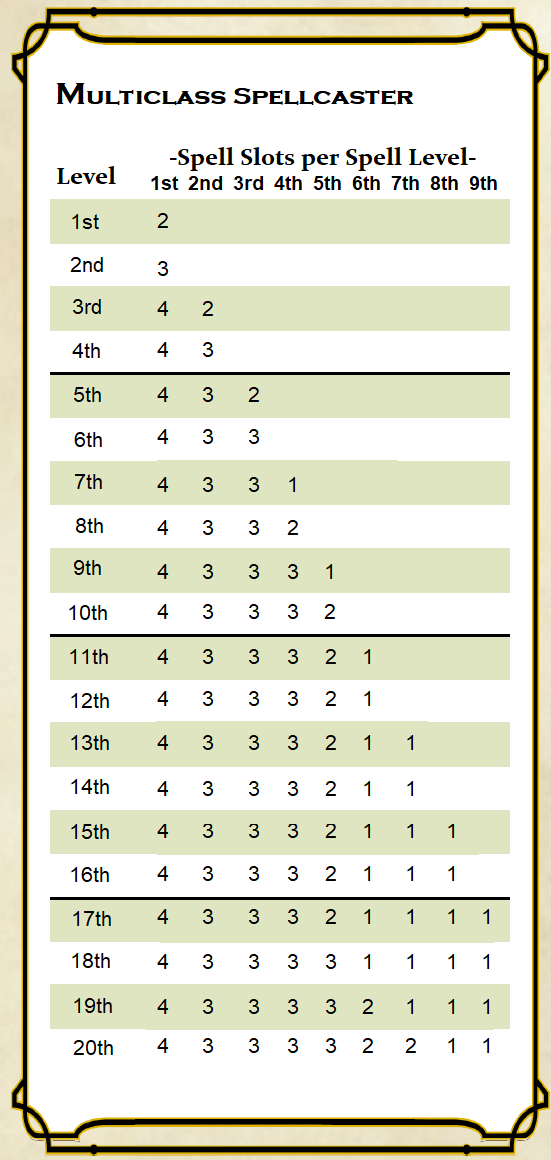Generic, Text: Multiclassing Guide
Remove these ads. Join the Worldbuilders Guild
Multiclassing Guide
Prerequisites
To qualify for a new class, you must have a minimum of a 13 in the Attribute or Attributes essentially for the class. Strength for Barbarians, Dexterity for Rogues, Intelligence for Artificers and Psions and Wizards, Wisdom for Clerics and Druids, Charisma for Bards and Sorcerers, Strength or Dexterity for Fighter, Intelligence or Wisdom or Charisma for Warlocks, Dexterity and Wisdom for Monks and Rangers, and Strength and Charisma for Paladins.
Hit Points and Hit Dice
You gain hit points depending on the class you have taken, adding your Constitution modifier to the dice as per normal. A d12 for Barbarians, d10 for Fighters and Paladins and Rangers, d8 for Artificers and Bards and Clerics and Druids and Monks and Rogues and Warlocks, and d6 for Psions and Sorcerers and Wizards.
Proficiency Bonus
Your proficiency bonus is always based on your total character level, not your level in a particular class. For example, if you are a fighter 3/rogue 2, you have the proficiency bonus of a 5th-level character, which is +3.
Proficiencies
When you gain your first level in a class other than your initial class, you gain a truncated set of proficiencies;
Artificer: Light armor, medium armor, shields, Thievery, Smithing
Barbarian: Shields, simple weapons, martial weapons
Bard: Light armor, one skill of your choice, one musical instrument of your choice
Cleric: Light armor, medium armor, shields
Druid: Light armor, medium armor, shields (druids will not wear armor or use shields made of metal)
Fighter: Light armor, medium armor, shields, simple weapons, martial weapons
Monk: Simple weapons, shortswords
Paladin: Light armor, medium armor, shields, simple weapons, martial weapons
Psion: Psionics skill
Ranger: Light armor, medium armor, shields, simple weapons, martial weapons, one skill from the class’s skill list
Rogue: Light armor, one skill from the class’s skill list, Thievery
Sorcerer: None
Warlock: Light armor, simple weapons
Wizard: Arcana skill
Class Features
When you gain a new level in a class, you get its features for that level. You don’t, however, receive the class’s starting equipment, and a few features have additional rules when you’re multiclassing: Extra Attack, Unarmored Defense, and Spellcasting.
Extra Attack
If you gain the Extra Attack class feature from more than one class, the features don’t add together. You can’t make more than two attacks with this feature unless it says you do (as the fighter’s version of Extra Attack does). Similarly, the warlock’s eldritch invocation Thirsting Blade doesn’t give you additional attacks if you also have Extra Attack.
Unarmored Defense
If you already have the Unarmored Defense feature, you can’t gain it again from another class.
Spellcasting
Your capacity for spellcasting depends partly on your combined levels in all your spellcasting classes and partly on your individual levels in those classes. Once you have the Spellcasting feature from more than one class, use the rules below. If you multiclass but have the Spellcasting feature from only one class, you follow the rules as described in that class.
Spells Known and Prepared: You determine what spells you know and can prepare for each class individually, as if you were a single-classed member of that class. If you are a ranger 4/wizard 3, for example, you know three 1st-level ranger spells based on your levels in the ranger class. As 3rd-level wizard, you know three wizard cantrips, and your spellbook contains ten wizard spells, two of which (the two you gained when you reached 3rd level as a wizard) can be 2nd-level spells. If your Intelligence is 16, you can prepare six wizard spells from your spellbook. Each spell you know and prepare is associated with one of your classes, and you use the spellcasting ability of that class when you cast the spell. Similarly, a spellcasting focus, such as a holy symbol, can be used only for the spells from the class associated with that focus.
Spell Slots: You determine your available spell slots by adding together all your levels in the bard, cleric, druid, sorcerer, and wizard classes, and half your levels (rounded down) in the artificer and paladin and ranger classes. Use this total to determine your spell slots by consulting the table on the left. If you have more than one spellcasting class, this table might give you spell slots of a level that is higher than the spells you know or can prepare. You can use those slots, but only to cast your lower-level spells. If a lower-level spell that you cast, like burning hands, has an enhanced effect when cast using a higher-level slot, you can use the enhanced effect, even though you don’t have any spells of that higher level. For example, if you are the aforementioned ranger 4/wizard 3, you count as a 5th-level character when determining your spell slots: you have four 1st-level slots, three 2nd-level slots, and two 3rd-level slots. However, you don’t know any 3rd-level spells, nor do you know any 2nd-level ranger spells. You can use the spell slots of those levels to cast the spells you do know — and potentially enhance their effects.
Pact Magic: If you have both the Spellcasting class feature and the Pact Magic class feature from the warlock class, you can use the spell slots you gain from the Pact Magic feature to cast spells you know or have prepared from classes with the Spellcasting class feature, and you can use the spell slots you gain from the Spellcasting class feature to cast warlock spells you know.






